Meet Small Number
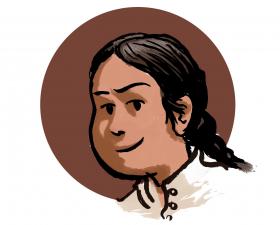
The main character in our animations thus far is a boy called Small Number. He is a bright, playful kid, with the ability to recognize patterns and calculate quickly.
Other characters introduced so far are Big Circle, Small Number’s best friend, Perfect Number, Small Number’s sister, and Small Number’s mother and grandparents. An important part of our stories is love. His grandparents, his mother, his sister, and his friend all love Small Number, and he loves them back.
To underline the universality of mathematics, Small Number and the plots of our stories are not attached to a particular time and space. In the first story, Small Number lives in a tipi settlement somewhere in the plains. In the second story he lives by a body of water, a river or a sea, and the third story is set in an urban environment.
Small Number Counts to 100
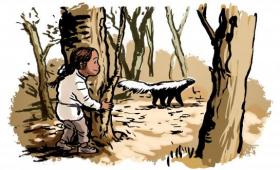
Our intention is to create stories in such a way that they allow for interpretations at multiple levels of mathematicalknowledge. For example, our first story, Small Number Counts to 100, can be shown to elementary school students as a counting practice/puzzle or as a pattern recognition problem. For high school students, it couldbe a way to introduce arithmetic progressions, modular addition, or an idea of number systems with a base different than 10.
Small Number and the Old Canoe
In Small Number and the Old Canoe, mathematics is present throughout the story with the hope that this experience will make at least some members of our young audience, with the moderator’s help, recognize more mathematics around them in their everyday lives. We use terms like smooth, shape, oval, and surface, the mathematical phraseology like It must be at least a hundred years old, and our artist, Mr. Simon Roy from Victoria, British Columbia, skillfully presents reflection (symmetry) of trees in water, and so on.
The idea behind this approach is to give the moderator a few openings to 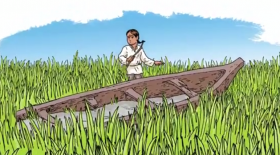 introduce or emphasize various mathematical objects, concepts, and terminology. The short film is a little math suspense story and our question is related only to the last part of it. The aim of the question is to lead to an introduction at an intuitive level of the concept of a function and the essence of the principle of inclusion-exclusion as a counting technique. We would also like to give our audience an opportunity to appreciate that in order to understand a math question, one often needs to read (or in this case, watch) a problem more than once.
introduce or emphasize various mathematical objects, concepts, and terminology. The short film is a little math suspense story and our question is related only to the last part of it. The aim of the question is to lead to an introduction at an intuitive level of the concept of a function and the essence of the principle of inclusion-exclusion as a counting technique. We would also like to give our audience an opportunity to appreciate that in order to understand a math question, one often needs to read (or in this case, watch) a problem more than once.
Small Number and the Basketball Tournament
The mathematical context of the third story, Small Number and the Basketball Tournament, contains some basic principles of combinatorics. The plot of the story and the closing question are structured in a manner that allows the  moderator to introduce the notion of permutations and combinations. Since the numbers used in the story are relatively small, this can be used to encourage the young audience to explore on their own. Mathematics is also present in the background. Small Number and his friends do mathematics after school in the Aboriginal Friendship Centre. He loves playing the game of Set and when he comes home his sister is just finishing her math homework. Small Number and his friend would like to participate in a big half-court tournament, and so on.
moderator to introduce the notion of permutations and combinations. Since the numbers used in the story are relatively small, this can be used to encourage the young audience to explore on their own. Mathematics is also present in the background. Small Number and his friends do mathematics after school in the Aboriginal Friendship Centre. He loves playing the game of Set and when he comes home his sister is just finishing her math homework. Small Number and his friend would like to participate in a big half-court tournament, and so on.
Small Number's Team
Veselin Jungic and Mark MacLean, Small Number's authors, are two mathematicians who are interested in promoting mathematics and who have enormous respect for Aboriginal culture traditions. As mathematicians, we have tried to be extremely careful with everything related to Aboriginal cultures. In their essence, our stories are inspired by what we have read in relevant literature, by what we heard from our Aboriginal friends, and by what we experienced working with the Aboriginal students.
Veselin and Mark partnered with Simon Roy and Andy Gavel to produce the stories and movies.
Simon Roy is a Canadian artist and writer. He was born and raised in Victoria, British Columbia. Simon graduated from the Alberta College of Art and Design in Calgary, Alberta. He was nominated for Shuster Awards for his work on the comic "Jan's Atomic Heart" in 2010 and on the comic "Prophet” in 2013. In December 2014, the publishing company Dark Horse released Simon "Tiger Lung" hardcover. In Simon's own words, "I'm a comic book artist, Dinosaur enthusiast, and slavic-culture nerd. What more could you need?" Simon has been drawings the Small Number stories since 2011.
Andy Gavel is an alumni of the Program in Film at the SFU School for the Contemporary Arts. Currently he is a graduate student at Ryerson University. Andy has directed all Small Number films.
A nice compliment
"I am currently taking a math additional qualifications course series, upgrading my teacher's qualifications so I am a math specialist. One of our assignments this week is to link math to Aboriginal children's literature. The first two students to post their findings used the Small Number books! They complimented the rich problem solving activity posed at the end of each. I now have to find other resources for my presentation, but that's okay. I am glad my school colleagues found Small Number!" (Melanie)
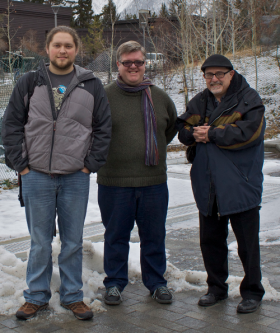 (
(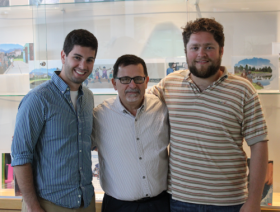
The Math Catcher Team – Simon, Mark, Veso – Andy, Veso, Simon

